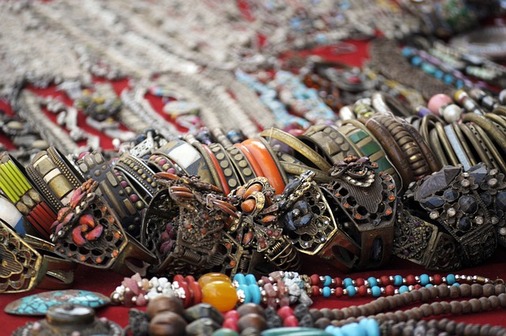
Antique jewelry is not just an accessory; it’s a precious piece of history, a legacy passed down through generations. These intricate treasures, with their timeless beauty, demand special care and attention. In this copious guide, we will delve into the art of cleaning and restoring antique jewelry, ensuring these precious keepsakes continue to shine for years to come.
Click here to have a glance at our post on Vintage Charm: How to Clean and Preserve Antique Lace and Linens
What to Know About Your Antique Jewelry
Before diving into the cleaning and restoration process, it’s essential to understand the type of antique jewelry you have. Different materials and gemstones require specific care. Here’s a breakdown:
Identify the Materials:
- Metal Type: Determine the metal composition of your jewelry. Common metals include gold, silver, platinum, and various alloys.
- Gemstones: Identify the gemstones in your jewelry. Common ones include diamonds, rubies, sapphires, emeralds, and pearls.
Know the Era:
- Research the Period: Understand the historical period of your antique jewelry. Victorian, Edwardian, Art Nouveau, and Art Deco are popular eras, each with its unique characteristics.
- Hallmarks: Look for hallmarks or maker’s marks, which can provide clues about the jewelry’s origin and age.
See also our post on The Ultimate Guide to Cleaning and Caring for Your Quartz Countertops
Gentle Cleaning Techniques
Cleaning antique jewelry requires a delicate touch to preserve its authenticity and value. Follow these simple steps to revive the sparkle without causing damage:
Basic Cleaning:
- Mild Soap Solution: Create a solution of warm water and mild soap. Dip a soft toothbrush into the mixture and gently scrub the jewelry, paying attention to crevices.
- Rinse Thoroughly: Rinse the jewelry under running water to remove soap residue.
Gemstone-Specific Cleaning:
- Diamonds: Soak diamonds in a mixture of equal parts water and ammonia for a few hours. Gently scrub with a soft brush and rinse.
- Pearls: Wipe pearls with a damp cloth. Avoid submerging them in water, as it can damage the nacre.
- Gemstones: Use a soft cloth to clean gemstones. Avoid abrasive cleaners that may scratch the surface.
Ultrasonic Cleaners:
- Caution: While ultrasonic cleaners can be effective, they are not suitable for all antique jewelry. Consult a professional or do thorough research before using one.
- Soft Settings Only: Ensure that the jewelry has secure settings, as ultrasonic vibrations can loosen stones.
See also our post on How to Clean and Maintain Antique Books: Preservation Techniques
Restoring Antique Jewelry to Its Former Glory
Restoration goes beyond cleaning; it involves repairing any damage and rejuvenating the piece. Here’s a step-by-step guide to restoring your antique jewelry:
Assessing Damage:
- Professional Appraisal: Seek a professional jeweler’s opinion to assess the overall condition and value of the piece.
- Identify Issues: Look for missing stones, damaged prongs, or signs of wear that need attention.
Repairs and Replacements:
- Stone Replacement: Replace missing or damaged stones with replicas matching the original.
- Re-Tipping Prongs: If prongs are worn, have them re-tipped to secure gemstones.
- Re-Sizing: Adjust the size of rings or bracelets if needed, but be mindful of preserving any engraved details.
Professional Restoration:
- Choose a Reputable Jeweler: Entrust valuable pieces to experienced jewelers specializing in antique restoration.
- Document the Process: Request documentation of the restoration process, including photographs, to maintain the jewelry’s provenance.
See also our post on How to Revive Old and Tarnished Jewelry: Cleaning Techniques which you will not want to miss.
Storing Antique Jewelry
Preserving the brilliance of antique jewelry extends beyond cleaning and restoration; proper storage is crucial to prevent deterioration over time.
Storage Conditions:
- Avoid Moisture: Store jewelry in a cool, dry place to prevent metal corrosion and gemstone damage.
- Separate Pieces: Keep jewelry in individual pouches or compartments to prevent scratching.
Regular Checks:
- Periodic Inspections: Regularly inspect your antique jewelry for any signs of damage or wear.
- Professional Cleaning: Schedule professional cleanings and inspections every few years to catch potential issues early.
Caring for Different Metals
Each metal has unique characteristics, and understanding their properties is vital for proper care.
Gold:
- Avoid Harsh Chemicals: Gold is a relatively soft metal, so avoid using harsh chemicals that can damage its surface.
- Polishing Cloth: Use a soft polishing cloth to restore the shine.
Silver:
- Tarnish Removal: Use a silver polishing cloth or a mild silver cleaner to remove tarnish.
- Anti-Tarnish Strips: Store silver jewelry with anti-tarnish strips to prevent tarnishing.
Platinum:
- Gentle Cleaning: Clean platinum with a mild soap solution and a soft brush.
- Professional Polishing: Periodically have platinum jewelry professionally polished to maintain its luster.
Here is our post on The Ultimate Guide to Cleaning and Organizing Your Jewelry Collection
Conclusion
Antique jewelry is a testament to craftsmanship and artistry, carrying stories from the past into the present. By following the steps outlined in this comprehensive guide, you can embark on a journey to preserve and revitalize these precious keepsakes. Whether you’re cleaning a family heirloom or considering professional restoration, the key is to approach the process with care and respect for the historical significance of each piece.
Remember, antique jewelry is more than adornment; it’s a connection to the past. Treat it with the reverence it deserves, and your cherished treasures will continue to captivate hearts for generations to come. Happy restoring!







